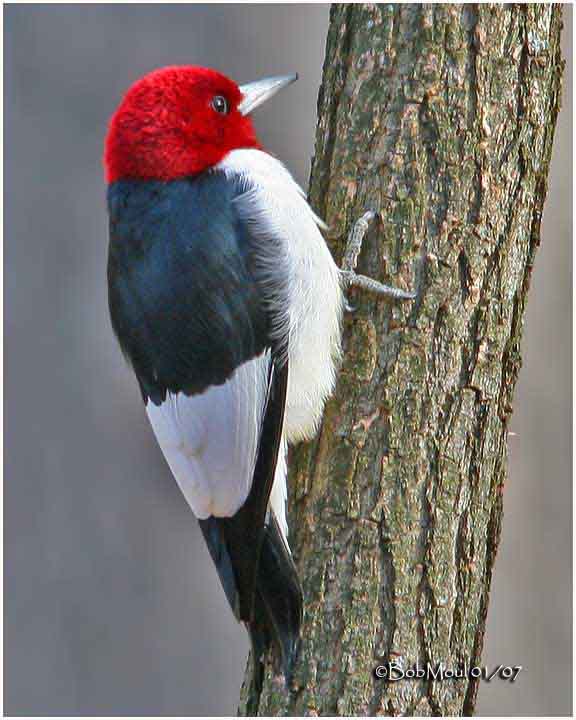
Red-headed Woodpecker
Melanerpes erythrocephalus
Piciforme Order – Picidae Family
BIOMETRICS:
Length: 19-23 cm; Wingspan: 42 cm; Weight: 56-91 g
LONGEVITY: up to 9 years

DESCRIPTION:
Red-headed Woodpecker has bright red head, neck and throat. Underparts are white. Back is bluish black. It shows a large white patch on the wings, and rump is white. Tail is black, with white outer feathers.
Bill is blue grey. Eyes are dark brown. Legs and feet are bluish grey, with zygodactylous feet.
Both sexes are similar, male is slightly larger than female.
Juvenile is brownish. It has grey head and two black wing bars on white secondary’s feathers.
Immature shows some red tinge on head.

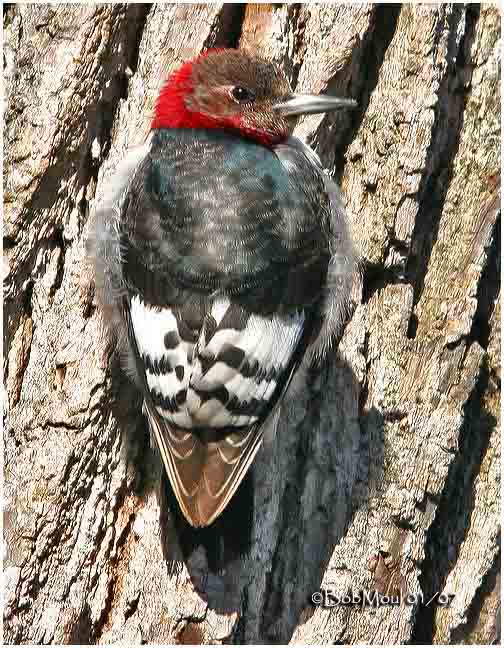
VOICE: SOUNDS BY XENO-CANTO
In breeding season, Red-headed Woodpecker utters a loud “queark”. Common call is guttural rattle “churr-churr”. Alarm call at nest is “krit-tar-rah” or “quarr-quarr-quarr”.
Drumming lasts one second and it is repeated two or three times.
HABITAT:
Red-headed Woodpecker feeds in open areas. It needs snags for nesting, roosting and foraging. It can be found in open deciduous woodlands, orchards, parks, agricultural areas, grasslands, forest edges, burned forests.
Habitat is similar in breeding and wintering range.
RANGE:
Red-headed Woodpecker ranges east to west from Rocky Mountains to Atlantic Ocean, and north to south from Manitoba and southern Ontario, to Texas, Gulf of Mexico and Florida.
BEHAVIOUR:
Migration of Red-headed Woodpecker depends of food resources in winter (acorns and beech nuts). It is gregarious out of breeding season, travelling in large flocks. Migration occurs by day and on short distances.
Red-headed Woodpecker uses a large variety of foraging techniques. It rarely excavates a hole in dead tree to find insects, and it may sallies out from a perch, to catch flying insects, or it drops to the ground to capture prey spotted from perch. It may expand the entrance of some hole-nests to reach eggs or nestlings.
It stores acorns and beech nuts in crevices or other holes, and sometimes, it seals its caches with chips of wood, bark or twigs. It may stores large insects, such as grasshoppers, for short time.
Red-headed Woodpecker is solitary. It defends its breeding territories and also its food areas in fall and winter.
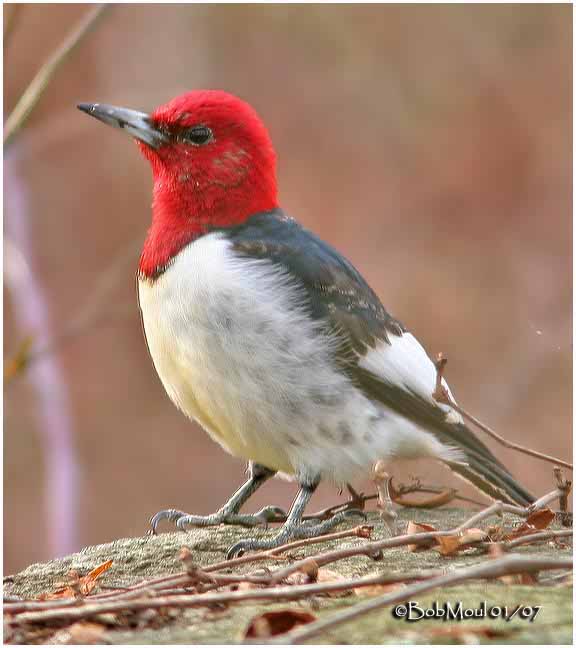
It uses calls and drumming in a variety of situations, such as defence of territory, courtship and copulation, and to communicate between them.
Male taps inside and female outside of the nest cavity during courtship. Displays include bowing head and spreading wings.
They are mainly monogamous, but polygyny may occur. Some pairs may mate together over several seasons.
Red-headed Woodpecker easily moves upwards, sidewise or backwards, but never with head downwards, as Nuthatches.
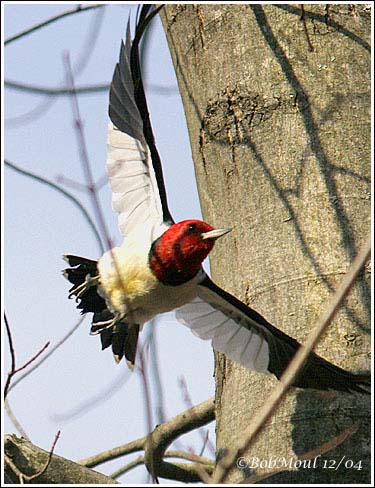
FLIGHT:
During migration, Red-headed Woodpeckers fly very high above trees, far apart. They propel themselves by repeated flaps of wings, at the end of each curve described in their flight.
Red-headed Woodpecker has an agile flight. It is able to catch flying insects on the wing, flycatcher fashion.
Chicks are strong fliers, able to catch their own food soon after fledging.
Woodpeckers fly alone or in small flocks, in wavy pattern, winging up and gliding down. They fly low over the ground, in undulating manner.
REPRODUCTION:
Red-headed Woodpecker is a solitary nester. Its nest is located in a tree cavity or a hole in dead stub of a live tree. It may be a natural cavity, or excavated by both adults, at about 1, 50 to 24 metres above the ground. Nest may be situated in utility poles or underside of roof.
To choose a place, male taps out of a cavity, and if female accepts it, she taps on the tree or pole that contains it.
Female lays 4 to 5 white eggs. Incubation lasts about 12 to 13 days, by both parents, male at night. Chicks hatch altricial. They are fed by both adults. They fledge at about 27 to 30 days of age, and are able to catch their own food very soon. They reach their sexual maturity at one year.
This species often produces two broods per season.
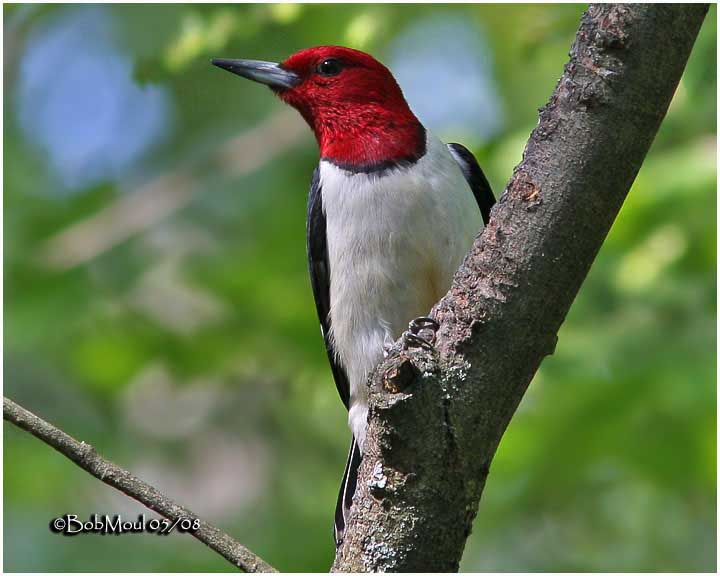
DIET:
Red-headed Woodpecker feeds on seeds, acorns and beech nuts, sap, corn, insects, bird eggs and nestlings, adult birds and mice.
PROTECTION / THREATS / STATUS:
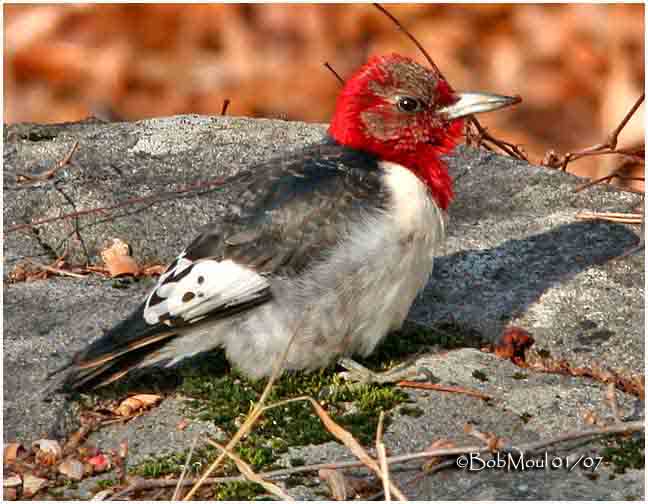
Red-headed Woodpecker is listed threatened species in most part of its range. Species is threatened by changes of its habitat, competition for nesting-holes with European Starlings, and increased removal of dead trees offering nest-sites.
Red-headed Woodpecker has some predators, such as raptors (hawks, falcons, owls), and red-foxes. Eggs and chicks are taken by snakes, raccoons and flying squirrels.
Fr: Pic à tête rouge
All : Rotkopfspecht
Esp : Carpintero Cabecirrojo
Ital : Picchio testarossa
Nd : Roodkopspecht
Sd : Rödhuvad hackspett
Photographs by Bob Moul
His website:
Nature Photography
Text by Nicole Bouglouan
Sources :
HANDBOOK OF THE BIRDS OF THE WORLD Vol. 7 by Josep del Hoyo-Andrew Elliott-Jordi Sargatal – Lynx Edicions – ISBN: 8487334377
FIELD GUIDE TO THE BIRDS OF NORTH AMERICA - National Geographic Society - ISBN: 0792274512
All About Birds (Cornell Lab of Ornithology)
What Bird-The ultimate Bird Guide (Mitchell Waite)
Wikipedia (Wikipedia, The Free Encyclopedia)
Animal Diversity Web (University of Michigan Museum of Zoology)